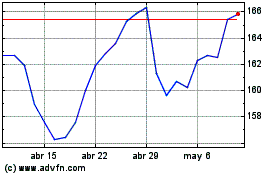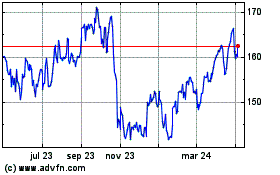Vicki Hollub goes all-in to best Chevron for Anadarko -- and
dominate a huge oil field
By Christopher M. Matthews, Bradley Olson and Cara Lombardo
This article is being republished as part of our daily
reproduction of WSJ.com articles that also appeared in the U.S.
print edition of The Wall Street Journal (May 8, 2019).
Driven by a risk-taking chief executive, Occidental Petroleum
Corp. is trying to swallow a competitor close to its own size,
outmaneuvering one of the world's oil giants in the process.
If it succeeds, CEO Vicki Hollub will win accolades and
Occidental will ward off growing threats from the giants in one of
the world's biggest oil fields. If not, Occidental could itself be
vulnerable to a takeover.
Occidental's battle with mammoth Chevron Corp. to buy Anadarko
Petroleum Corp. has riveted the oil industry since it erupted in
mid-April. Occidental currently has the highest offer on the table,
one that Anadarko said Monday it now favors over Chevron's. A new
offer from Chevron could come any time.
Ms. Hollub lined up $10 billion of backing from Warren Buffett
and cut a deal with a French oil company, all in the space of two
days, to press her audacious project.
She is pushing it against the wishes of some of Occidental's
major investors, spooked by the cost and risk of mounting debt.
Mutual-fund giant T. Rowe Price Group intends to vote against
Occidental's board slate at the oil company's annual meeting
Friday, said a Price portfolio manager, John Linehan.
T. Rowe Price believes financing arranged from Mr. Buffett's
Berkshire Hathaway is "extraordinarily expensive," Mr. Linehan
said, adding: "We are concerned that as the bidding war intensifies
there will be a winner's curse for whoever buys Anadarko."
David Katz, president and chief investment officer of Occidental
shareholder Matrix Asset Advisors,, which expressed concerns to
Occidental's board, said, "Vicki Hollub seems committed to getting
this done at any cost." He said her " obligation should be to
maximize value, not to maximize the empire. We urge the company to
consider selling rather than buying."
Though it's fraught with danger, Ms. Hollub believes a deal for
Anadarko would be a rare chance to transform the company's size and
sway in the Permian Basin of Texas and New Mexico, the epicenter of
U.S. shale production, said people familiar with her strategy.
Though the fifth-largest U.S. oil company, according to this
thinking, Occidental is just too small to match Chevron and Exxon
Mobil Corp. as they squeeze other producers there with methodically
orchestrated expansions.
Top spot
Adding Anadarko's assets would vault Occidental to the top spot
in the huge field, according to consulting firm Rystad Energy.
Without major change, Occidental, now second, would be only the
fifth-largest there by 2025, according to Rystad's forecasts.
"If we're going to get in this thing, we're going to win it,"
said Glenn Vangolen, one of Ms. Hollub's top lieutenants and a
senior vice president. "We're not going to dip our toes in the
water and mess up the stock."
Occidental's offer for Anadarko is $38 billion. That tops a $33
billion deal Chevron struck to buy Anadarko last month. This week,
Occidental sweetened its bid further by upping the amount of cash
it includes.
That step indirectly added to the concerns of the objecting
Occidental investors. By reducing the number of new shares
Occidental would have to issue, the move eliminated the need to get
shareholder approval for a deal.
Ms. Hollub has argued Occidental's investors benefit from the
move because it makes the company's bid more likely to succeed.
Occidental declined to make Ms. Hollub available for this
article.
Those who know Ms. Hollub say beneath her plain-spoken persona
lies an intense competitor. An Alabama native and former French
horn player in the University of Alabama's "Million Dollar Band,"
Ms. Hollub, 59 years old, is a passionate fan of Crimson Tide
football. Her prized possessions include a portrait of the school's
legendary former coach, Paul "Bear" Bryant.
Since she became CEO three years ago -- the first female chief
executive at a large oil company -- current and former senior
executives saw her zeal for a big deal as a departure from her
predecessor, Stephen Chazen, who favored small "bolt-on"
transactions and tended to avoid big risks.
Given the size of Anadarko -- which has an enterprise value of
about $55.5 billion, only 7% smaller than Occidental -- Ms. Hollub
knew an acquisition of it would stretch Occidental to its limits.
She expected shareholders to trust her judgment that an acquisition
was necessary to ensure the company had the wherewithal to continue
competing against oil giants, said people who know her.
Ms. Hollub courted Anadarko, also a substantial player in the
Permian Basin, for nearly two years. Early last month she thought
she was close to a deal. But after Occidental revised a
still-confidential offer of about $76 a share temporarily down to
about $72 in early April, she said Anadarko CEO Al Walker stopped
responding to her calls and text messages.
Occidental sent a revised $76-a-share offer on April 11,
according to people familiar with the issue. By that time, Anadarko
had decided to move ahead with Chevron's offer due to concerns that
re-engaging in discussions with Occidental would prompt Chevron to
walk away, according to people familiar with Anadarko's
thinking.
On April 12, Anadarko announced it would be sold to Chevron for
roughly $65 a share. Ms. Hollub was frustrated. Instead of giving
up, she went public with a new $76-a-share offer -- and over a
whirlwind weekend lined up nearly $19 billion in financial
ammunition.
Occidental needed a big war chest to compete with Chevron. Ms.
Hollub and her advisers discussed approaching a Middle Eastern
sovereign-wealth fund, said people familiar with her thinking. They
determined that would take too long, one of the people said.
Another option seemed to lie in Omaha, Neb. Bank of America
Chief Executive Brian Moynihan had visited Occidental's Houston
office before the Chevron deal to discuss financing options. After
the Chevron-Anadarko deal was announced -- and Occidental needed
cash fast -- Mr. Moynihan offered to reach out Mr. Buffett, who was
looking for ways to invest Berkshire Hathaway's large pile of cash,
another person familiar with the maneuverings said.
An investment from him would have the bonus of looking like an
endorsement of an Occidental deal from the famed investor, this
person said.
Mr. Moynihan called Mr. Buffett to broker a meeting. Ms. Hollub
planned a visit to Omaha for that weekend.
First, however, she made a quick trip to Paris on April 26 and
struck a conditional deal to sell Anadarko's extensive African
assets to oil company Total SA for $8.8 billion, reducing
Occidental's leverage after an Anadarko takeover.
Her next trip was to Omaha. With her was a top lieutenant and
former Bank of America banker, Oscar Brown, Mr. Buffett said at
Berkshire's annual meeting on Saturday.
Within an hour, they struck a deal for Berkshire to spend $10
billion for 100,000 Occidental preferred shares yielding 8% if the
Anadarko deal went through.
It gave Ms. Hollub more room to raise her offer. "They
absolutely know we have $10 billion and we're not going to tell
them how to structure their transaction and do anything else," Mr.
Buffett said on Saturday.
Decades ago, Occidental was one of a handful of oil explorers
led by charismatic wildcatters -- companies like J. Paul Getty's
Getty Oil Co. and Leon Hess's Hess Corp. -- that took risks in
places others avoided. Occidental boomed under Armand Hammer, who
took over what was a sleepy California oil company in 1957 and
turned it into a substantial player, mainly through an oil
concession in Libya he obtained in the late 1960s.
Competing with companies five or six times its size, Occidental
developed an expertise at pumping oil from places that others were
willing to discard. One such was the Permian Basin, which had once
been among the world's hottest oil fields but by the late 1990s and
early 2000s was left for dead by most of the majors.
Occidental developed ways to get more oil out of aging
conventional wells there by injecting carbon dioxide into them. It
is now a leader in the process, which analysts say could extend the
lives not only of conventional wells but of shale wells, which
produce prodigiously at first but rapidly decline.
That has also put Occidental at the forefront of the burgeoning
business of capturing carbon to forestall climate change. Last
year, Ms. Hollub helped lobby for legislation, since passed, to
extend and increase carbon-capture tax credits.
"She was the go-to phone call," said former Sen. Heidi Heitkamp
of North Dakota. "She's not like a lot of executives who might just
say, 'I need this.' She will put the credibility of her company
into something she believes in."
Ms. Hollub, who studied mineral engineering at Alabama, worked
on oil rigs right out of college and landed at Occidental in 1982
when it bought the company she worked for, Cities Service. She rose
through Occidental's ranks, running operations from Russia to
Venezuela to West Texas.
One of her first big jobs was overseeing Occidental oil fields
in a remote part of Ecuador, where she was essentially the mayor of
a small city as she managed drilling operations in the Amazon
jungle, said the company's Mr. Vangolen.
Workers there, mostly men, "were all very skeptical of her,
being a female in the middle of the jungle, where there basically
were no women, " said Mr. Vangolen. "Very quickly, she figured out
how to get everyone's input and get them onboard."
Glass ceiling
Edward Djerejian, a former chairman of Occidental and onetime
U.S. ambassador to Israel and Syria, recalled Ms. Hollub impressing
the board years ago with a presentation on Permian Basin
operations. Around 2014, he and then-CEO Mr. Chazen identified her
as Mr. Chazen's successor.
"The major consideration was her competence," he said. "We also
obviously realized if we made this move we'd be breaking the glass
ceiling in the oil-and-gas industry."
With Ms. Hollub as CEO, Occidental has performed in the middle
of the pack. After she took over in April 2016, the company stuck
to Ms. Hollub's pledge not to lay off employees resulting from the
industry downturn that began with a late-2014 plunge in oil
prices.
But Occidental has shed nearly $9 billion in market value during
her tenure while its share prices have fallen about 11%. Much of
that decline has come as a result of the offer. Through April 11,
the day before Chevron's announcement, when Occidental's interest
was also revealed, the company's performance in total return to
investors was better than its smaller peers but worse than that of
major oil companies including Chevron or ConocoPhillips.
In discussions with shareholders about the company's all-in bid
for Anadarko, Ms. Hollub and her team have invoked an acquisition
Occidental made in 2000. The takeover then of Altura Energy gave
Occidental the rights to depleted conventional wells in the Permian
Basin, wells Occidental has since reinvigorated with carbon
injection. The $3.6 billion price for Altura meant that Occidental
essentially would acquire for nothing the takeover target's shale
reserves, which frackers would later figure out how to tap.
Similar to that deal, Occidental believes that in an acquisition
of Anadarko, it would acquire not just that company's known oil
reserves in the Permian Basin but potentially much more. On a
Monday call with investors, Ms. Hollub described a deal for
Anadarko as "transformational."
Write to Christopher M. Matthews at
christopher.matthews@wsj.com, Bradley Olson at
Bradley.Olson@wsj.com and Cara Lombardo at
cara.lombardo@wsj.com
(END) Dow Jones Newswires
May 08, 2019 02:47 ET (06:47 GMT)
Copyright (c) 2019 Dow Jones & Company, Inc.
Chevron (NYSE:CVX)
Gráfica de Acción Histórica
De Mar 2024 a Abr 2024

Chevron (NYSE:CVX)
Gráfica de Acción Histórica
De Abr 2023 a Abr 2024
